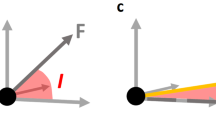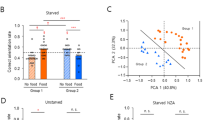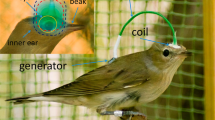Abstract
Replying to C. M. Hein, S. Engels, D. Kishkinev & H. Mouritsen Nature 471, doi:10.1038/nature09875 (2011)
Hein and colleagues1 challenge our 2002 paper2, claiming that they cannot replicate our findings. The paper had two conclusions: (1) magnetic compass information is mediated by the eyes, as had been proposed by Ritz and colleagues3, and (2) the magnetic compass is lateralized in favour of the right eye. The new data do not contradict the first conclusion; in fact, this has been supported by a recent paper from the authors4. It is only the second conclusion they question, although it has been demonstrated not only in two species of migrants2,5, but also in domestic chickens6 and is the basis of a new paper indicating an interaction between contour vision and magnetoreception7.
Similar content being viewed by others
Main
These obvious differences in findings require explanations, and offhand, three possibilities come to mind:
(1) The authors do not observe migratory orientation, but a ‘fixed direction’ response. ‘Fixed direction’ responses do not involve the inclination compass based on the radical pair mechanism, but are polar responses originating in the magnetite-based receptors in the beak8; they are not lateralized9. The observed scatter is in agreement with this interpretation, as ‘fixed directions’ are often more scattered than compass responses8. Critical tests to distinguish between the two types of responses, like inverting the vertical component of the magnetic field, are missing.
(2) The studies by Hein et al.10 were autumn experiments, where young birds fly innate compass courses11, whereas ours2,5,7,8 involved spring experiments, where birds can use true navigation to head back to the familiar breeding regions12. There are indications that the navigational ‘map’ is lateralized in favour of the right eye/left brain system13, which, in turn, could have led to a lateralized response.
(3) Another difference between the studies is the number of tests per bird. Whereas we tested the birds two2,5 or three7,9 times, the authors’ means are based “on 4.11 ± 2.76 (s.d.) active and oriented tests per condition”, which implies that the individual birds have been tested more often. Hence the total time the birds had their right eye covered was considerably longer than in our studies. In certain tasks acquired unihemispherically, an interhemispheric transfer is observed in animals that have to rely on the naive eye; in some cases, this takes just a few hours14. A similar transfer may have occurred when the right eye was covered for a longer period. The observation that the vectors of the birds with the right eye covered are the shortest in both magnetic conditions is in agreement with this interpretation. This could also explain the weaker lateralization observed in pigeons15, where the total time of covering the right eye was also much longer. It would mean that although the avian magnetic compass is normally mediated by the right eye only, left-eye input is able to substitute the process after a critical amount of time.
In summary, there are considerable differences between the studies. Which of them or which possible combination of them caused the difference in findings cannot be decided at present, but will be determined by future experiments.
References
Hein, C. M., Engels, S., Kishkinev, D. & Mouritsen, H. Robins have a magnetic compass in both eyes. Nature 471 10.1038/nature09875 (2011)
Wiltschko, W., Traudt, J., Güntürkün, O., Prior, H. & Wiltschko, R. Lateralisation of magnetic compass orientation in a migratory bird. Nature 419, 467–470 (2002)
Ritz, T., Adem, S. & Schulten, K. A model for photoreceptor-based magnetoreception in birds. Biophys. J. 78, 707–718 (2000)
Zapka, M. et al. Visual but not trigeminal mediation of magnetic compass information in a migratory birds. Nature 461, 1274–1277 (2009)
Wiltschko, W., Munro, U., Ford, H. & Wiltschko, R. Lateralisation of magnetic compass orientation in Silvereyes, Zosterops lateralis. Aust. J. Zool. 51, 597–602 (2003)
Rogers, L. J., Munro, U., Freire, R., Wiltschko, R. & Wiltschko, W. Lateralized response of chicks to magnetic cues. Behav. Brain Res. 186, 66–71 (2008)
Stapput, K., Güntürkün, O., Hoffmann, K. P., Wiltschko, R. & Wiltschko, W. Magnetoreception of directional information in birds requires non-degraded vision. Curr. Biol. 20, 1259–1262 (2010)
Wiltschko, R., Stapput, K., Thalau, P. & Wiltschko, W. Directional orientation of birds by the magnetic field under different light conditions. J. R. Soc. Interface 7, S163–S177 (2010)
Wiltschko, W., Gehring, D., Denzau, S., Güntürkün, O. & Wiltschko, W. Interaction of the magnetite-based receptors in the beak with the visual system underlying ‘fixed direction’ responses in birds. Front. Zool. 7, 24 (2010)
Hein, M. et al. Night-migratory garden warblers can orient with the magnetic compass using the left, the right or both eyes. R. Soc. Interface 7, S227–S233 (2010)
Pedeck, A. C. Two types of orientation in migratory Sturnus vulgaris and Fringilla coelebs as revealed by displacement experiments. Ardea 46, 1–37 (1958)
Perdeck, A. C. An experiment of the orientation of juvenile starlings during spring migration: an addendum. Ardea 71, 255 (1983)
Bingman, V. P., Siegel, J. J., Gagliardo, A. & Erichson, J. T. Representing the richness of avian spatial cognition: properties of a lateralized homing pigeon hippocampus. Rev. Neurosci. 17, 17–28 (2006)
Skiba, M., Diekamp, B., Prior, H. & Güntürkün, O. Lateralized interhemispheric transfer of color cues: evidence of dynamic coding principles of visual lateralization in pigeons. Brain Lang. 73, 254–273 (2000)
Wilzeck, C., Wiltschko, W., Güntürkün, O., Wiltschko, R. & Prior, H. Lateralization of the magnetic compass orientation in pigeons. J. R. Soc. Interface 7, S235–S240 (2010)
Author information
Authors and Affiliations
Corresponding author
Ethics declarations
Competing interests
Competing financial interests: declared none.
Rights and permissions
About this article
Cite this article
Wiltschko, W., Traudt, J., Güntürkün, O. et al. Wiltschko et al. reply. Nature 471, E1 (2011). https://doi.org/10.1038/nature09876
Received:
Accepted:
Published:
Issue Date:
DOI: https://doi.org/10.1038/nature09876
This article is cited by
-
Long-distance navigation and magnetoreception in migratory animals
Nature (2018)
-
Pigeons may ‘hear’ magnetic fields
Nature (2012)
-
Colony genetic structure in the Australian jumper ant Myrmecia pilosula
Insectes Sociaux (2012)
Comments
By submitting a comment you agree to abide by our Terms and Community Guidelines. If you find something abusive or that does not comply with our terms or guidelines please flag it as inappropriate.



